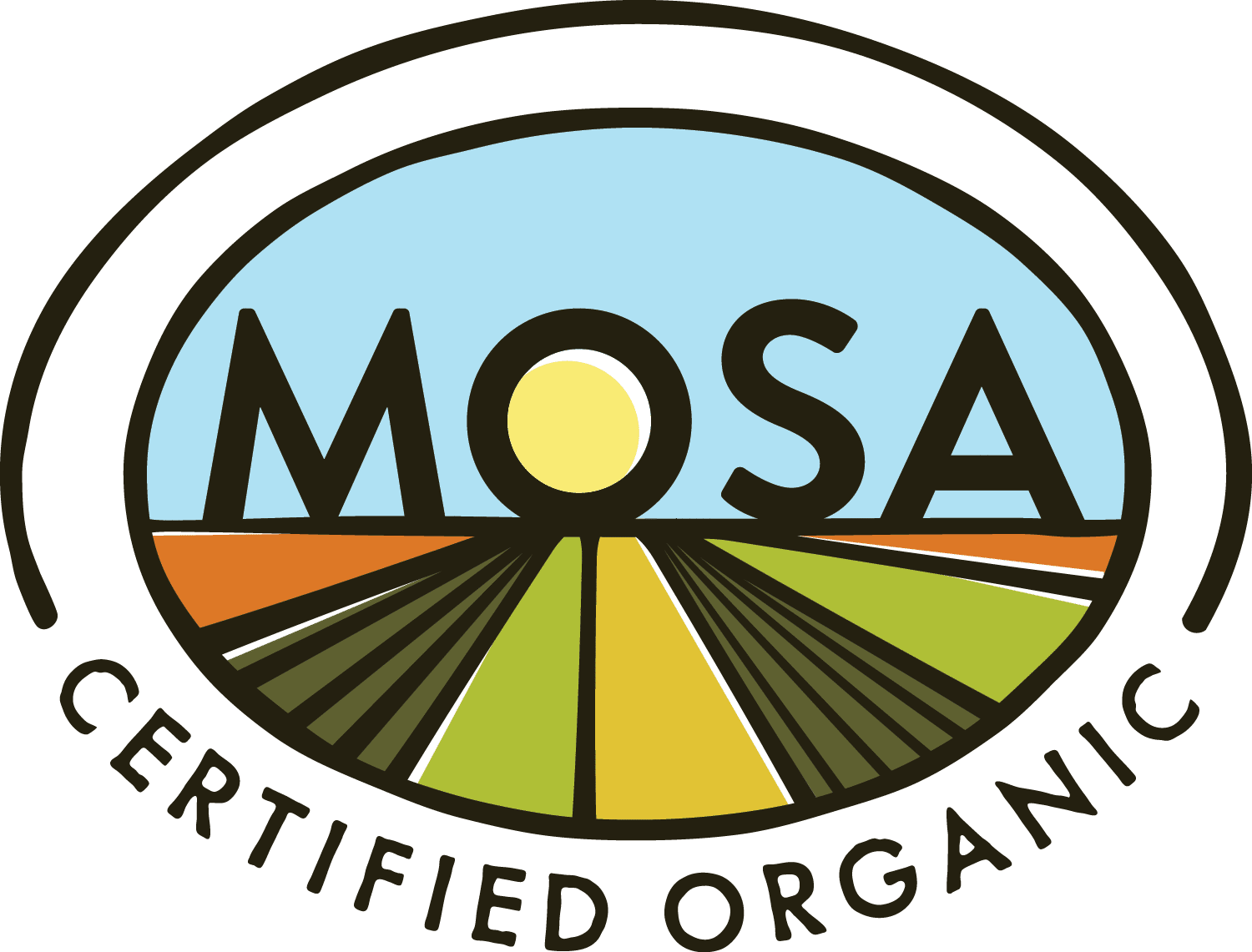
By Laurel Blomquist | On May 28, 2019, Gwenyn Hill Farm was visited by an inspector from MOSA, or Midwest Organic Services Association. Annually,  we are carefully evaluated by our inspector for organic certification. The inspector checks out the fields as well as the areas where we wash and pack our produce before selling it. He also scrupulously reviews our records–where we purchase our seed, how we plant it, and what inputs we use to grow it and maintain it before harvest.
we are carefully evaluated by our inspector for organic certification. The inspector checks out the fields as well as the areas where we wash and pack our produce before selling it. He also scrupulously reviews our records–where we purchase our seed, how we plant it, and what inputs we use to grow it and maintain it before harvest.
Our General Manager, Linda Halley, is a trained organic inspector herself, so she helps the team prepare for the certification process. For the consumer, however, what defines certified organic remains somewhat confusing. There is a lot of conflicting information out there about practices on organic farms. I will attempt to clarify practices at Gwenyn Hill Farm.
Conventional Fertilizers = Nitrogen
I’m going to start with fertilizer. Conventional agriculture utilizes nitrogen fertilizers that boost plant growth quickly. The United States built factories to manufacture nitrogen munitions during World War II. After the war, these factories shifted from making nitrogen explosives to making nitrogen fertilizers. The vast majority of American farmers use these fertilizers. When excess nitrogen is applied, runoff from these farm fields flows down the Mississippi River, ending up in the gulf of Mexico. The nitrogen-rich waters at the mouth of the Mississippi cause large algae blooms every summer, resulting in an environment toxic to much marine life.
At Gwenyn Hill Farm, we don’t use nitrogen fertilizers. We use a system of management to build soil nutrients every year. We test our soils every three years so that we have a better idea of what nutrients to apply.
Cover Cropping
One of the things we do to replenish the soil is cover cropping. We plant a wide variety of cover crops, such as oats and peas in the spring, sorghum sudan grass and buckwheat in the summer, and winter rye and hairy vetch in the fall.These cover crops are carbon-rich organic matter which we till back into the soil. As the cover crop residue decomposes, it improves the tilth of our heavy clay soils. Over time, with the use of cover crops, soils become more like a sponge than a dense brick. Water penetrates the soil surface and filters down rather than sheeting off like it would in a parking lot, carrying tiny soil particles and any excess fertilizer or chemicals into our surface streams, lakes and rivers.
Crop Rotations
Another method we use is crop rotations. Within the vegetable area at Gwenyn Hill, I make sure to rotate families of crops from year to year. For example, tomatoes, potatoes, peppers, and eggplant all belong to the same plant family, solanacea. Each year, I rotate all the crops from one family to a different part of the field. One third of our fields receive a cover crop as their rotation. Rotation prevents diseases from developing in the soil, confuses insect pests, and gives the soil a chance to rest, either by providing a different set of nutrients to a different plant family, or by getting a cover crop, which returns those nutrients to the soil.

We also add organic matter to the soil in several forms. We use a plastic mulch to cover the soil to plant tomatoes, peppers, summer squash, cucumbers, melons, watermelons, and summer lettuces. In order to keep the weeds down between these rows, we use straw mulch. At the end of the season, we pull out the plastic and incorporate the straw mulch back into the soil. In the late fall and early winter, we add animal manure to the soil, naturally rich in nitrogen from digested grass and hay. Lastly, we add organic compost that we purchase from Purple Cow. The composting process enhances fungal and bacterial life and even a light application can add billions of soil microbes to our fields, greatly improving the cycling and availability of nutrients to crop roots.
Fish Hydrolysate & Other Animal Inputs
For the vegetable crops, in addition to the above methods of field management, we use fish hydrolysate as our main boost to transplanted crops. This often comes as a surprise to folks, that vegetables like to eat fish, but they do. We give the transplants a dose of “magic juice,” which contains fish, kelp meal, minerals, beneficial bacteria, and mycorrhizal fungi, when they are moved from the warm safety of the greenhouse to our wagons for hardening off. We fertilize the transplants with another dose of fish when they are transplanted to the field. These treatments give the plants the boost they need to transition from living in the protected greenhouse to the wide open fields.
We also use dry fertilizers, specially formulated for vegetable crops, to enhance the viability of the fields that we are planting with cash crops. They are made of ingredients such as kelp, composted chicken manure, feather meal, potassium magnesium sulfate, calcium sulfate, borate, zinc sulfate, manganese sulfate, copper sulfate, and humates. These get spread over the fields and incorporated just before we plant into the ground. They release calcium and trace minerals slowly over the course of the growing season, giving plants what they need for their growth stage into their fruiting stage.
All of these techniques work together to grow healthy, nutrient-dense plants. You can taste the difference each time you take a bite.
Laurel Blomquist thinks that vegetables need to be grown in soil for the full expression of their flavor and nutrients.
